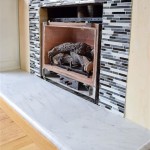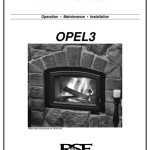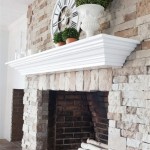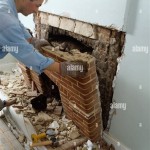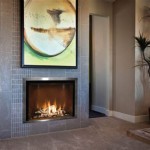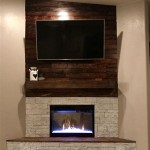Shelves Above Fireplace: Design, Functionality, and Considerations
The space above a fireplace often presents a design challenge for homeowners. It is typically a focal point in a room, and leveraging this advantageous position with shelving can offer both aesthetic and practical benefits. Incorporating shelves above a fireplace allows for showcasing decorative items, storing books, or simply adding visual interest to an otherwise blank wall. However, several factors must be carefully considered before undertaking such a project, from fire safety and weight capacity to the overall architectural style of the room.
Effectively integrating shelves above a fireplace requires a blend of functionality and aesthetics. The selection of materials, the design of the shelves, and the items displayed on them should all contribute to the room's overall ambiance. Moreover, ensuring the structural integrity of the shelves and their ability to withstand heat exposure is paramount. Neglecting these considerations could lead to potential safety hazards and detract from the intended visual appeal.
Understanding Heat Dynamics and Material Selection
One of the primary concerns when installing shelves above a fireplace is heat management. The rising heat from a burning fireplace can significantly affect the longevity and safety of the shelves and the items placed on them. Different materials react differently to heat exposure, and understanding these reactions is crucial for making informed decisions.
Wood, for example, is a popular choice for shelving due to its aesthetic appeal and versatility. However, wood is also combustible and can dry out and warp when exposed to sustained heat. Therefore, selecting a hardwood with a high density and low resin content is generally recommended. Using a heat-resistant sealant or varnish can further protect the wood from damage. Alternatively, consider using engineered wood products like MDF or plywood, which are less prone to warping but still require protection from direct heat.
Metal shelves offer an alternative to wood. Steel or wrought iron shelves are non-combustible and can withstand high temperatures. However, metal can become hot to the touch, making it less suitable for handling frequently accessed items. Furthermore, metal can conduct heat, potentially affecting items stored nearby. If opting for metal shelves, ensure they are properly insulated or positioned far enough away from the fireplace opening to mitigate heat transfer.
Stone or concrete shelves present another durable and heat-resistant option. These materials are naturally fireproof and can add a rustic or contemporary touch to the room. However, stone and concrete are often heavier and require more robust support structures. Careful consideration must be given to the load-bearing capacity of the wall and the method of installation.
Design Considerations and Shelf Placement
Beyond material selection, the design and placement of shelves above a fireplace directly impact the visual appeal and functionality of the space. Factors such as shelf spacing, depth, and overall configuration should be carefully planned to create a cohesive and balanced look.
Shelf spacing depends on the types of items to be displayed. Taller items, such as vases or sculptures, require more vertical space. Bookshelves, on the other hand, necessitate consistent spacing to accommodate various book sizes. Consider creating a mix of shelf heights to add visual interest and accommodate different objects. A general guideline is to maintain a consistent spacing between shelves or to create a gradual increase or decrease in spacing to guide the eye.
Shelf depth is another critical consideration. Deeper shelves provide more storage space but can also make the wall feel crowded. Shallower shelves, on the other hand, offer a more streamlined look but may limit storage options. The optimal depth depends on the size of the room and the intended use of the shelves. A depth of 8 to 12 inches is generally suitable for displaying decorative items, while bookshelves may require a depth of 10 to 14 inches.
The overall configuration of the shelves should complement the architectural style of the room and the design of the fireplace. Symmetrical arrangements create a sense of formality and balance, while asymmetrical arrangements offer a more modern and dynamic look. Consider extending the shelves to the full width of the wall to create a cohesive and integrated design. Alternatively, flanking the fireplace with separate shelving units can create a more modular and flexible arrangement.
Floating shelves, which appear to be attached directly to the wall without visible supports, offer a clean and contemporary aesthetic. These shelves require sturdy hardware and careful installation to ensure they can support the intended weight. Bracketed shelves, on the other hand, provide more visible support and can add a traditional or industrial touch to the room. The choice between floating and bracketed shelves depends on the desired aesthetic and the structural requirements of the project.
Installation Techniques and Safety Precautions
Proper installation is crucial for ensuring the safety and longevity of shelves above a fireplace. The wall's structural integrity, the weight-bearing capacity of the shelves, and the method of attachment all play a vital role. Neglecting these aspects can lead to shelf collapse, damage to the wall, and potential injuries.
Before beginning the installation process, it is essential to locate wall studs. Shelves should be securely attached to studs whenever possible to provide maximum support. A stud finder can be used to locate the studs behind the drywall. If studs are not available in the desired locations, use heavy-duty drywall anchors to provide additional support. Selecting anchors that are appropriate for the weight of the shelves and the items to be stored on them is essential.
Use appropriate hardware for attaching the shelves to the wall. Screws should be long enough to penetrate deeply into the studs or anchors. Washers can be used to distribute the load and prevent the screw heads from pulling through the shelf material. Ensure that the hardware is made of durable and corrosion-resistant materials to withstand the heat and humidity generated by the fireplace.
When installing shelves above a fireplace, consider the proximity to the firebox. Maintain a safe distance between the shelves and the opening of the fireplace to prevent the items on the shelves from overheating or catching fire. Consult local building codes and fire safety regulations for specific guidelines on clearance requirements. Installing a heat shield or deflector above the fireplace opening can further protect the shelves from direct heat exposure.
After the shelves have been installed, test their weight-bearing capacity by gradually adding weight. Ensure that the shelves are stable and do not sag or deflect excessively. If any signs of instability are observed, reinforce the shelves with additional supports or adjust the weight distribution. Regularly inspect the shelves for any signs of damage or wear, and promptly address any issues to prevent potential hazards.
Furthermore, consider the placement of electrical outlets and wiring when planning the shelving arrangement. Avoid obstructing access to outlets or damaging existing wiring. If necessary, relocate outlets or install new wiring to accommodate the shelves. Ensure that all electrical work is performed by a qualified electrician to comply with safety regulations.
The selection of items placed on the shelves should also be carefully considered from a fire safety perspective. Avoid storing flammable materials, such as paper, fabric, or aerosol cans, near the fireplace. Use fire-resistant containers for storing smaller items, and regularly dust the shelves to prevent the accumulation of flammable dust. Placing a fire extinguisher nearby provides an extra layer of safety in case of emergencies.
By considering heat dynamics, design aesthetics, and installation techniques, shelves above fireplace can becomes a functional and visually appealing feature in any living space. The integration of shelves adds both utility and beauty to the focal point of the room.

Great Idea To Place A Shelf Above The Fireplace Mantel For Extra Storage And Display Surrounds Home Electric With

Design Idea For Above A Fireplace Stack The Shelves

Design Idea For Above A Fireplace Stack The Shelves

Collection Of Premium Wood Fireplace Mantels Dogberry

Floating Shelf Mantel Fireplace Shabby Coastal Farmhouse Decor

Mantel Shelves Fireplace Shelf Scarlett Fireplaces

30 Tips To Diy And Decorate Your Fireplace Mantel Shelf

30 Tips To Diy And Decorate Your Fireplace Mantel Shelf

Fireplace Shelves Natural Oak And Wooden Mantels Bonfire

36 Fireplace Decor Ideas Modern Mantel
Related Posts

